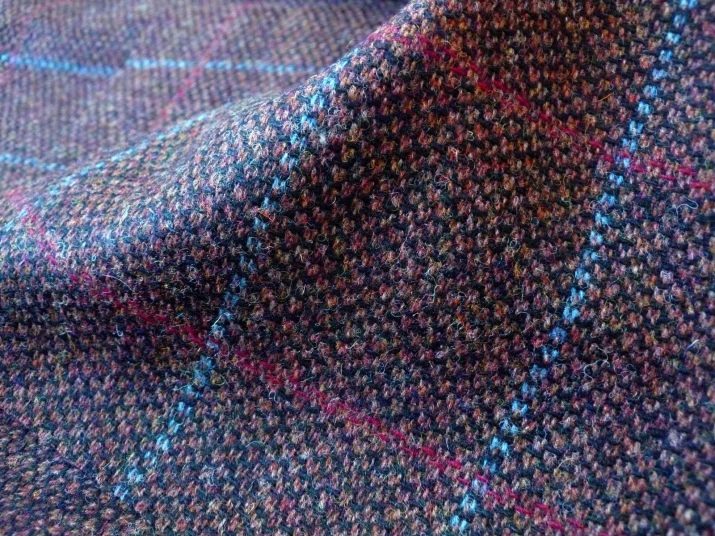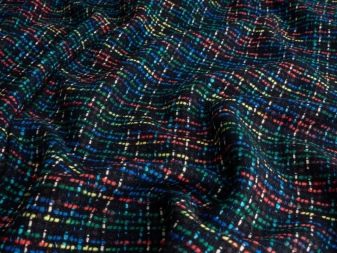Features of Chanel-style fabric

The famous chanel fabric gained fame back in the 40s of the last century. It was then that the trendsetter of fashion and style, Coco Chanel, began to introduce new fabrics and styles into a woman's wardrobe, following her principle of "luxurious simplicity". At this time, she became interested in fabrics for men, from which sportswear was sewn: tweed, bouclé fabric. Inspired by the simplicity and low-key beauty of these fabrics, Coco creates on their basis its own variety - the chanel fabric.

Owning her own weaving factory, she herself drew up the colors of her fabrics, using natural colors in noble shades.
general description
At its core, Chanel is soft, loose, with knots in natural fibers, reminiscent of tweed and bouclé, it drapes perfectly... Chanel belongs to premium fabrics, it contains wool, silk, cotton, sometimes synthetic fibers are added for strength: viscose or polyester. For the most part, this is a melange canvas with a more or less pronounced effect. Chanel is used for sewing suits, jackets, skirts, trousers, and even hats. The classic basic colors of the canvas are black and white, as well as blue, pink and their combinations.

Views
Chanel fabric is subdivided into several varieties depending on its composition. Let's consider the most popular ones.
- Boucle... The composition of this fabric is viscose, cotton, silk, as well as their combinations. Designed for making dresses, lightweight in texture, elastic, the body breathes well in it.

- Tweed or jersey. This fabric is used for sewing costumes. It is denser, usually woolen, durable in texture, color dots and nodules are distributed in a chaotic manner on its surface.


- Donegal... This is a rather thin fabric, similar in structure to homespun, with a scattering of multi-colored knots along the surface. Both women's and men's suits are sewn from it.

- Chanel herringbone tweed. This classic fabric is used for sewing coats and suits and has not lost its popularity to this day.

- Covercot... Textured fabric with interlacing of three colors. In this case, one of them is the main one, and the other two serve as an interlacing. They sew jackets, jackets, sometimes outerwear from it.

- Houndstooth tweed. The classic option is black and white, but recently you can find a wide variety of other color combinations. Used for sewing suits and jackets.

- Shaumbray... An inexpensive canvas with a wide variety of beautiful colors, but the most common shade is blue. Warm soft fabric, very practical to use.

- Tweed harris. The most famous type of fabric with scattered multicolored splashes. The fabric is dense and warm, needed for tailoring exclusive jackets and jackets that can be worn with both trousers and jeans.

- Shepsword... Suiting fabric, classic in nature.

Applications
Chanel can be confidently attributed to the ageless classics, so its scope is very wide. It is ideal for all kinds of elegant suits, as well as riding sets, classic skirts and jackets.



Until now, the fashion world remembers the legendary jacket made of this fabric, created by Coco, which is still relevant and popular today. In the modern world, it can even be worn with jeans. Even accessories can be sewn from the material: bags and hats that complement clothes.
Fashion designers around the world are constantly working to design such a cut of clothing so that nothing hinders movement, and the products look elegant and expensive. They sew the following options for things:
- all kinds of dresses: cases and sundresses;
- pants;
- skirts;
- jackets and vests;
- office suits;
- outerwear.




Often, fringes or laces with buttons are used in decoration: this is also the development of Coco Chanel, a feature of her style. Products made from the material are of high quality, with good care they will last a long time and retain a presentable appearance.

To make suits and jackets fit well on the figure, lining is also used for their tailoring.
Chanel has undeniable advantages:
- high strength and durability;
- ease;
- the fabric does not wrinkle;
- breathable, but does not allow moisture to pass through;
- fits perfectly;
- does not fade;
- tactilely pleasant structure;
- durability in operation.

There were almost no drawbacks in the Chanel fabric, however, such small nuances can be noted:
- very loose structure of this material;
- products can visually fill up a little;
- fabric tends to crumble.

Care rules
Taking care of things made of Chanel fabric, given its loose structure, should be careful. If the composition contains wool, try to avoid frequent washings. Try dry cleaning on light dirt or contact a dry cleaner. This is especially true for items such as outerwear or a suit.
Small items such as skirts or trousers, hand wash very gently, use detergents for wool, cashmere or silk... The water temperature should not exceed 35 degrees. At higher temperatures, the product may shrink unwantedly. Be careful with the spin, it should be minimal. It is better to blot the product with any material that absorbs moisture well.

Clothes are usually dried horizontally, avoiding deformation. The item is laid out on a dense, absorbent fabric, a towel is placed on top and rolled into a roll. Leave to dry completely. The fabric is ironed from the inside out through gauze or other material, stored in covers.
Chanel clothes are a sign of good taste, a classic that should be in every woman's wardrobe. Coco Chanel herself said: "Fashion passes, style remains." The textile industry now produces a wide range of chanel fabrics in a wide variety of colors. Therefore, there will be no obstacles for the implementation of any design ideas.


Regular buyers of clothes made from this material appreciate its quality, comfort and impeccable style, because the ageless classics from Chanel will never go out of fashion.








